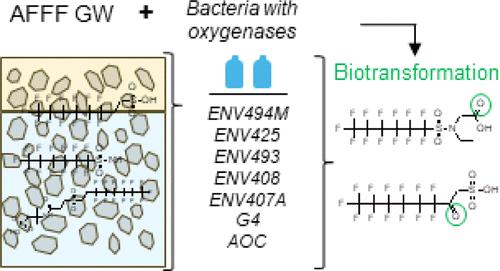当前位置:
X-MOL 学术
›
Environ. Sci. Technol.
›
论文详情
Our official English website, www.x-mol.net, welcomes your
feedback! (Note: you will need to create a separate account there.)
Biotransformation of PFAA Precursors by Oxygenase-Expressing Bacteria in AFFF-Impacted Groundwater and in Pure-Compound Studies with 6:2 FTS and EtFOSE
Environmental Science & Technology ( IF 10.8 ) Pub Date : 2024-07-22 , DOI: 10.1021/acs.est.4c01931 Jessica A LaFond 1 , Rachael Rezes 2 , Marzieh Shojaei 3 , Todd Anderson 4 , W Andrew Jackson 1 , Jennifer L Guelfo 1 , Paul B Hatzinger 2
Environmental Science & Technology ( IF 10.8 ) Pub Date : 2024-07-22 , DOI: 10.1021/acs.est.4c01931 Jessica A LaFond 1 , Rachael Rezes 2 , Marzieh Shojaei 3 , Todd Anderson 4 , W Andrew Jackson 1 , Jennifer L Guelfo 1 , Paul B Hatzinger 2
Affiliation

|
Numerous US drinking water aquifers have been contaminated with per- and polyfluoroalkyl substances (PFAS) from fire-fighting and fire-training activities using aqueous film-forming foam (AFFF). These sites often contain other organic compounds, such as fuel hydrocarbons and methane, which may serve as primary substrates for cometabolic (i.e., nongrowth-linked) biotransformation reactions. This work investigates the abilities of AFFF site relevant bacteria (methanotrophs, propanotrophs, octane, pentane, isobutane, toluene, and ammonia oxidizers), known to express oxygenase enzymes when degrading their primary substrates, to biotransform perfluoroalkyl acid (PFAA) precursors to terminal PFAAs. Microcosms containing AFFF-impacted groundwater, 6:2 fluorotelomer sulfonate (6:2 FTS), or N-ethylperfluorooctane sulfonamidoethanol (EtFOSE) were inoculated with the aerobic cultures above and incubated for 4 and 8 weeks at 22 °C. Bottles were sacrificed, extracted, and subjected to target, nontarget, and suspect screening for PFAS. The PFAA precursors 6:2 FTS, N-sulfopropyldimethyl ammoniopropyl perfluorohexane sulfonamide (SPrAmPr-FHxSA), and EtFOSE transformed up to 99, 71, and 93%, respectively, and relevant daughter products, such as the 6:1 fluorotelomer ketone sulfonate (6:1 FTKS), were identified in quantities previously not observed, implicating oxygenase enzymes. This is the first report of a suite of site relevant PFAA precursors being transformed in AFFF-impacted groundwater by bacteria grown on substrates known to induce specific oxygenase enzymes. The data provide crucial insights into the microbial transformation of these compounds in the subsurface.
中文翻译:

在受 AFFF 影响的地下水中以及使用 6:2 FTS 和 EtFOSE 的纯化合物研究中,表达加氧酶的细菌对 PFAA 前体进行生物转化
美国许多饮用水含水层都受到使用水成膜泡沫 (AFFF) 的消防和消防训练活动中产生的全氟烷基物质 (PFAS) 和多氟烷基物质 (PFAS) 的污染。这些位点通常含有其他有机化合物,例如燃料碳氢化合物和甲烷,它们可以作为共代谢(即非生长相关)生物转化反应的主要底物。这项工作研究了 AFFF 位点相关细菌(甲烷氧化菌、丙酸菌、辛烷、戊烷、异丁烷、甲苯和氨氧化剂)将全氟烷基酸 (PFAA) 前体生物转化为末端 PFAA 的能力,这些细菌已知在降解其主要底物时表达加氧酶。将含有 AFFF 影响的地下水、6:2 氟调聚物磺酸盐 (6:2 FTS) 或N-乙基全氟辛烷磺酰胺乙醇 (EtFOSE) 的微生态用上述需氧培养物接种,并在 22°C 下孵育 4 周和 8 周。瓶子被牺牲、提取,并进行目标、非目标和可疑的 PFAS 筛查。 PFAA 前体 6:2 FTS、N-磺丙基二甲基氨丙基全氟己烷磺酰胺 (SPrAmPr-FHxSA) 和 EtFOSE 的转化率分别高达 99%、71% 和 93%,以及相关的子产物,例如 6:1 氟调聚物酮磺酸盐( 6:1 FTKS),其数量以前未观察到,涉及加氧酶。这是关于一系列与位点相关的 PFAA 前体在受 AFFF 影响的地下水中被生长在已知可诱导特定加氧酶的底物上的细菌转化的第一份报告。这些数据为这些化合物在地下的微生物转化提供了重要的见解。
更新日期:2024-07-22
中文翻译:

在受 AFFF 影响的地下水中以及使用 6:2 FTS 和 EtFOSE 的纯化合物研究中,表达加氧酶的细菌对 PFAA 前体进行生物转化
美国许多饮用水含水层都受到使用水成膜泡沫 (AFFF) 的消防和消防训练活动中产生的全氟烷基物质 (PFAS) 和多氟烷基物质 (PFAS) 的污染。这些位点通常含有其他有机化合物,例如燃料碳氢化合物和甲烷,它们可以作为共代谢(即非生长相关)生物转化反应的主要底物。这项工作研究了 AFFF 位点相关细菌(甲烷氧化菌、丙酸菌、辛烷、戊烷、异丁烷、甲苯和氨氧化剂)将全氟烷基酸 (PFAA) 前体生物转化为末端 PFAA 的能力,这些细菌已知在降解其主要底物时表达加氧酶。将含有 AFFF 影响的地下水、6:2 氟调聚物磺酸盐 (6:2 FTS) 或N-乙基全氟辛烷磺酰胺乙醇 (EtFOSE) 的微生态用上述需氧培养物接种,并在 22°C 下孵育 4 周和 8 周。瓶子被牺牲、提取,并进行目标、非目标和可疑的 PFAS 筛查。 PFAA 前体 6:2 FTS、N-磺丙基二甲基氨丙基全氟己烷磺酰胺 (SPrAmPr-FHxSA) 和 EtFOSE 的转化率分别高达 99%、71% 和 93%,以及相关的子产物,例如 6:1 氟调聚物酮磺酸盐( 6:1 FTKS),其数量以前未观察到,涉及加氧酶。这是关于一系列与位点相关的 PFAA 前体在受 AFFF 影响的地下水中被生长在已知可诱导特定加氧酶的底物上的细菌转化的第一份报告。这些数据为这些化合物在地下的微生物转化提供了重要的见解。











































 京公网安备 11010802027423号
京公网安备 11010802027423号